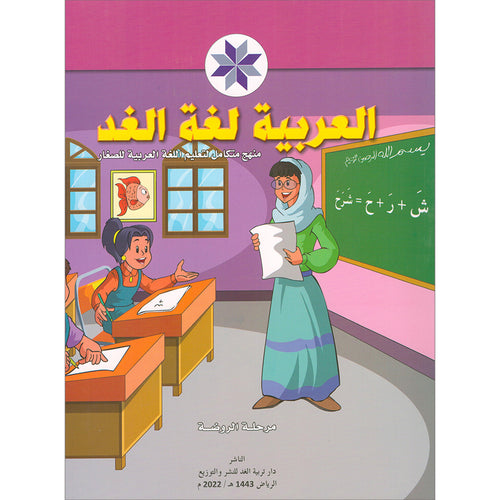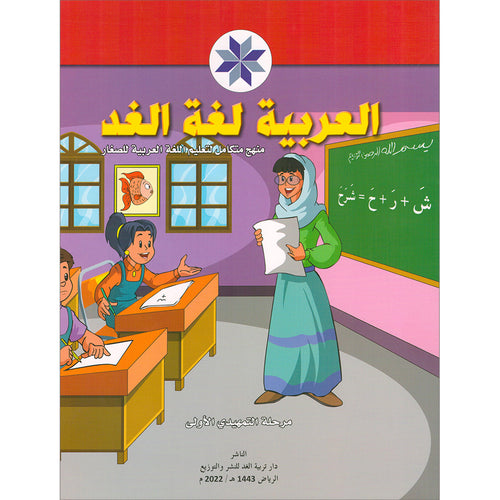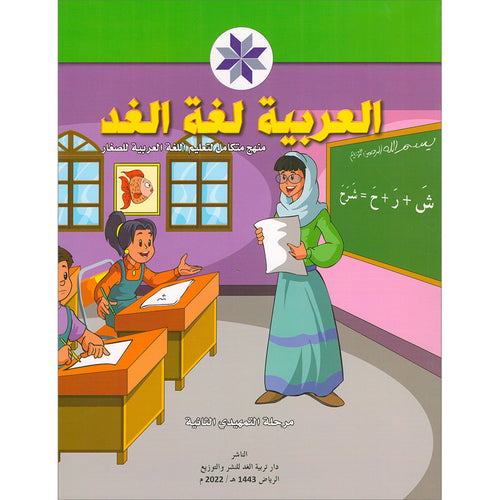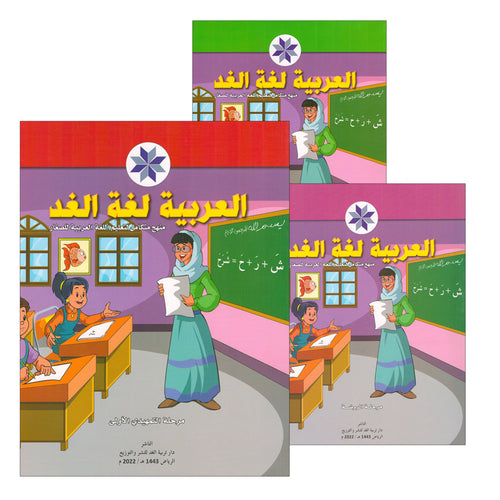Filters
Arabic is the Language of Tomorrow for Children - Pre-K and KG Levels
4 products
/pages/pre-k-2nd-level A Comprehensive Curriculum for Teaching Arabic for Children
Philosophy of the Curriculum:
- The series encompasses all educational stages.
- It is designed according to modern global standards of quality in language teaching.
- The series provides a curriculum that equips learners with essential skills.
- It offers an engaging curriculum that appeals to learners
- The series provides a curriculum that does not rely on a bridging language.
Objectives and Components of the Series: The series aims to enable learners to communicate both verbally and in writing in Arabic.
Time Allocation for Teaching the Series: Each stage is taught over approximately 100 sessions (1 session = 40 minutes) per level.
Cultural Content: The series introduces elements of Arab-Islamic culture in an appealing and engaging manner for children, while also providing aspects of general culture shared among children.
Linguistic Content:
- Introducing the Arabic phonetic system with its various features.
- Providing vocabulary sourced from a child’s lexicon.
- Equipping children with fundamental grammatical structures.
Teaching Methods: The series employs various methods, including stories, songs, dialogues, language games, and entertainment.
It contains different types of language exercises suitable for children.
Each book includes several tests to assess and measure the student’s progress in learning Arabic, with a test after every unit.
Integration of Language Skills: The series covers the four main language skills—listening, speaking, reading, and writing—in an integrated and balanced manner, with special attention to speaking, listening comprehension, expression, reading, and writing.
Picture Dictionary: Each book includes a picture dictionary at the end.
Vocabulary List: At the end of each book, there is a list containing all the vocabulary introduced, along with an Arabic-English dictionary for children and an English-Arabic glossary.
Preschool (Ages 4-5) and Kindergarten (Ages 5-6):
Key features of the curriculum include:
- Simplicity, gradual progression, and ease of use while engaging the child’s emotions and stimulating their imagination and creativity.
- Providing linguistic material to enable verbal communication.
- Adopting modern educational methods in teaching children.
- Training children to control their grip on the pen.
- Developing the child’s thinking skills.
- Practicing motor skills in writing.
سلسلة العربية لغة الغد
منهج متكامل في تعليم اللغة العربية
فلسفة المنهج:
- أن تشمل السلسلة جميع المراحل التعليمية .
- أن تعدَّ السلسلة وفقًا لمعايير الجودة العالمية الحديثة في تعليم اللغات
- أن توفر السلسلة منهجًا يكسب الدارسين المهارات الأساسية
- أن توفر السلسلة منهجًا محببًا للمتعلمين من غير أبنائها .
- أن توفر السلسلة منهجًا لا يستعين بلغة وسيط.
تقديم أنماط من الثقافة العربية الإسلامية بأسلوب جذاب وشائق للطفل في هذه السن، كما تمده بألوان من الثقافة العامة المشتركة بين الأطفال
المحتوى اللغوي:.
- تقديم النظام الصوتي للعربية بظواهره المختلفة.
- تقديم مفردات تستمد من قاموس الطفل.
- إمداد الطفل والطالب بعدد من التراكيب النحوية الأساسية
- استخدمت في السلسلة أساليب متنوعة مثل: القصص والأناشيد والأغاني والحوارات والألعاب اللغوية والتسلية
- وتحتوي السلسلة على أنواع مختلفة من التدريبات اللغوية التي تلائم الطفل
- شتمل كل كتاب من كتب السلسلة على عدد من الاختبارات للتقويم، وقياس تقدم الطالب في تعلّم اللغة، ويرد الاختبار بعد كل وحدة
تتناول السلسلة المهارات اللغوية الرئيسية الأربع من استماع وكلام وقراءة وكتابة بطريقة متكاملة ومتوازنة، مع توجيه عناية خاصة للكلام وفَهم المسموع والتعبير والقراءة والكتابة
القاموس المصور
يحتوي كل كتاب من كتب السلسلة على قاموس مصور يرد في نهاية الكتاب
قائمة المفردات:
توجد قائمة في آخر كل كتاب تحتوي على جميع المفردات التي قدمت في كل كتاب. بالإضافة إلى قاموس عربي إنجليزي للأطفال مع مسرد انجليزي عربي
مرحلة الروضة (4-5 سنوات) ومرحلة التمهيدي (5-6 سنوات)
من اهم سمات المنهج:
- مراعاة البساطة والتدرج وسهولة الأداء ومخاطبة وجدان الطفل وإثارة خياله وتنمية روح الابتكار والإبداع لديه
- مد الطفل بمادة لغوية تمكنه من التواصل الشفهي.
- الأخذ بأحدث الطرق التربوية في تعليم الطفل.
- التدريب على التحكم في الإمساك بالقلم.
- تنمية مهارات التفكير لدى الطفل.
- ممارسة الجانب الحركي في الكتابة.
Filters








